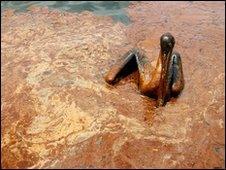BP cap captures '10,000 barrels' a day in US Gulf
- Published
A containment cap on a ruptured well in the Gulf of Mexico is now funnelling off 10,000 barrels of oil a day, BP's chief executive Tony Hayward says.
The amount has risen since Saturday, and implies more than half the estimated 12,000 to 19,000 barrels leaking each day is now being captured.
The spill has been described as the biggest environmental disaster in US history.
Mr Hayward told the BBC that BP would restore the Gulf to its original state.
Speaking on the Andrew Marr Show, Mr Hayward said: "As we speak, the containment cap is producing around 10,000 barrels of oil a day to the surface."
Asked what amount of the estimate that represented, the BP chief executive said it was expected to be "the majority, probably the vast majority" of the oil gushing out.
"We have a further containment system to implement in the course of this coming week which will be in place by next weekend so when those two are in place, we would very much hope to be containing the vast majority of the oil."
His company, he said, was going to stop the leak and take care of the consequences.
"We're going to clean up the oil, we're going to remediate any environmental damage and we are going to return the Gulf coast to the position it was in prior to this event. That's an absolute commitment, we will be there long after the media has gone, making good on our promises."
But the man in charge of the federal efforts to cope with the spill said no-one should be pleased "as long as there's oil in the water".
Coast Guard Adm Thad Allen told CNN the spill was "an insidious enemy that's attacking our shores".
'Nightmare'
The Deepwater Horizon rig sank on 20 April after an explosion, killing 11 workers.
Both BP and the US government have been criticised for the response so far.

The environmental impact has been described as the worst in US history
President Barack Obama has pledged to stand with the residents of Louisiana until they are "made whole".
Mr Obama has said he will ensure that BP is financially accountable for the damaged caused.
The containment cap is designed to funnel most of the leaking oil to a boat on the surface. It will be followed by a further containment system that involves using the pipes of a failed, previous operation to divert more oil to another vessel; and by a separate method - due to be in place by the end of this month - which is expected to be able to operate in hurricane conditions.
BP is also digging two relief wells which it hopes will provide a permanent solution to the leak - but they are not due to be completed until August.
The estimates for the total amount of oil that has leaked since the spill began vary widely from 20 million to 45 million gallons.
Four states have so far been affected by the spill - Louisiana, Mississippi, Alabama and Florida.
The oil risks affecting some of the famous white beaches of Florida, whose economy is heavily dependent on tourism.
One-third of the Gulf's federal waters remain closed to fishing, and the spill has killed and injured birds and marine animals.
"These waters are my backyard, my life," boat captain Dave Marino from Myrtle Grove, Louisiana, told AP news agency. "It's a nightmare. It looks like it's going to be wave after wave of it and nobody can stop it."
The oil has steadily spread east, and there are fears it could devastate the shoreline with the hurricane season coming up.
BP, whose share price has dropped by a third since the accident, has been coming under fire for spending a reported $50m on TV advertising to improve its image while the crisis was still going on.
BP says it has spent more than $1bn so far on clean-up and containment efforts since the Deepwater Horizon rig accident.